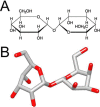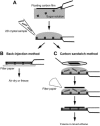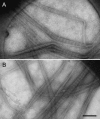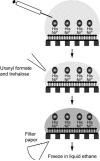The use of trehalose in the preparation of specimens for molecular electron microscopy
- PMID: 21752659
- PMCID: PMC3156378
- DOI: 10.1016/j.micron.2011.06.005
The use of trehalose in the preparation of specimens for molecular electron microscopy
Abstract
Biological specimens have to be prepared for imaging in the electron microscope in a way that preserves their native structure. Two-dimensional (2D) protein crystals to be analyzed by electron crystallography are best preserved by sugar embedding. One of the sugars often used to embed 2D crystals is trehalose, a disaccharide used by many organisms for protection against stress conditions. Sugars such as trehalose can also be added to negative staining solutions used to prepare proteins and macromolecular complexes for structural studies by single-particle electron microscopy (EM). In this review, we describe trehalose and its characteristics that make it so well suited for preparation of EM specimens and we review specimen preparation methods with a focus on the use of trehalose.
Copyright © 2011 Elsevier Ltd. All rights reserved.
Figures








Similar articles
-
Carbon sandwich preparation preserves quality of two-dimensional crystals for cryo-electron microscopy.Microscopy (Oxf). 2013 Dec;62(6):597-606. doi: 10.1093/jmicro/dft038. Epub 2013 Jul 23. Microscopy (Oxf). 2013. PMID: 23883606 Free PMC article.
-
7A projection map of the S-layer protein sbpA obtained with trehalose-embedded monolayer crystals.J Struct Biol. 2007 Dec;160(3):313-23. doi: 10.1016/j.jsb.2007.06.002. Epub 2007 Jun 15. J Struct Biol. 2007. PMID: 17638580 Free PMC article.
-
Electron cryomicroscopy of membrane proteins: specimen preparation for two-dimensional crystals and single particles.Micron. 2011 Feb;42(2):107-16. doi: 10.1016/j.micron.2010.07.004. Epub 2010 Jul 16. Micron. 2011. PMID: 20678942 Free PMC article. Review.
-
Trehalose embedding technique for high-resolution electron crystallography: application to structural study on bacteriorhodopsin.J Electron Microsc (Tokyo). 1999;48(5):653-8. doi: 10.1093/oxfordjournals.jmicro.a023731. J Electron Microsc (Tokyo). 1999. PMID: 15603052
-
Sample preparation of biological macromolecular assemblies for the determination of high-resolution structures by cryo-electron microscopy.Microscopy (Oxf). 2016 Feb;65(1):23-34. doi: 10.1093/jmicro/dfv367. Epub 2015 Dec 15. Microscopy (Oxf). 2016. PMID: 26671943 Review.
Cited by
-
Comprehensive microcrystal electron diffraction sample preparation for cryo-EM.Nat Protoc. 2025 May;20(5):1275-1309. doi: 10.1038/s41596-024-01088-7. Epub 2024 Dec 20. Nat Protoc. 2025. PMID: 39706914 Review.
-
Lyophilization for Formulation Optimization of Drug-Loaded Thermoresponsive Polyelectrolyte Complex Nanogels from Functionalized Hyaluronic Acid.Pharmaceutics. 2023 Mar 13;15(3):929. doi: 10.3390/pharmaceutics15030929. Pharmaceutics. 2023. PMID: 36986789 Free PMC article.
-
Carbon sandwich preparation preserves quality of two-dimensional crystals for cryo-electron microscopy.Microscopy (Oxf). 2013 Dec;62(6):597-606. doi: 10.1093/jmicro/dft038. Epub 2013 Jul 23. Microscopy (Oxf). 2013. PMID: 23883606 Free PMC article.
-
Seeing the Supracolloidal Assemblies in 3D: Unraveling High-Resolution Structures Using Electron Tomography.ACS Mater Au. 2023 Nov 9;4(3):238-257. doi: 10.1021/acsmaterialsau.3c00067. eCollection 2024 May 8. ACS Mater Au. 2023. PMID: 38737122 Free PMC article. Review.
-
Enhanced imaging of lipid rich nanoparticles embedded in methylcellulose films for transmission electron microscopy using mixtures of heavy metals.Micron. 2017 Aug;99:40-48. doi: 10.1016/j.micron.2017.03.019. Epub 2017 Apr 10. Micron. 2017. PMID: 28419915 Free PMC article.
References
-
- Abeyrathne PD, Chami M, Pantelic RS, Goldie KN, Stahlberg H. Preparation of 2D crystals of membrane proteins for high-resolution electron crystallography data collection. Methods Enzymol. 2010;481:25–43. - PubMed
-
- Adrian M, Dubochet J, Lepault J, McDowall AW. Cryo-electron microscopy of viruses. Nature. 1984;308:32–36. - PubMed
-
- Adrian M, Dubochet J, Fuller SD, Harris JR. Cryo-negative staining. Micron. 1998;29:145–160. - PubMed
Publication types
MeSH terms
Substances
Grants and funding
LinkOut - more resources
Full Text Sources

